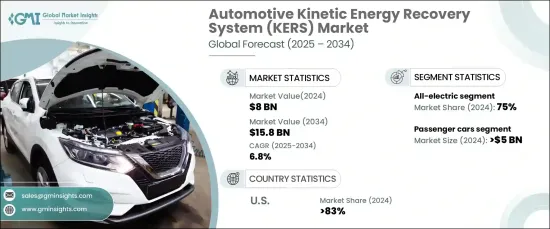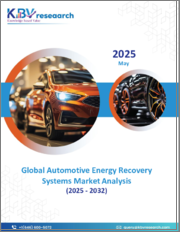
|
시장보고서
상품코드
1665352
자동차용 운동 에너지 회생 시스템 시장 기회, 성장 촉진요인, 산업 동향 분석, 예측(2025-2034년)Automotive Kinetic Energy Recovery System (KERS) Market Opportunity, Growth Drivers, Industry Trend Analysis, and Forecast 2025 - 2034 |
||||||
세계의 자동차용 운동 에너지 회생 시스템(KERS) 시장은 2024년에 80억 달러로 평가되며, 2025-2034년에 CAGR 6.8%로 성장할 것으로 예측됩니다. KERS와 회생 제동 시스템의 통합은 제동 에너지를 재사용 가능한 전력으로 변환하여 자동차의 에너지 효율에 혁명을 일으키고 있습니다. 자동차의 에너지 효율에 혁명을 일으키고 있습니다. 이 혁신적인 기술은 기존 연료에 대한 의존도를 최소화하여 세계 지속가능성 목표에 완벽하게 부합합니다. 자동차 제조업체들은 하이브리드 및 전기자동차에 KERS를 탑재하여 에너지 절감, 성능 향상, 엄격한 배기가스 규제 준수를 위해 KERS를 장착하는 움직임이 가속화되고 있습니다.

도시화의 급속한 발전과 스마트 시티 개념의 부상으로 친환경 교통 솔루션에 대한 수요가 증가하고 있으며, KERS는 대도시에서 흔히 볼 수 있는 정지 후 이동(stop-and-go) 교통에서 에너지 사용을 최적화하여 도시 모빌리티의 핵심으로 부상하고 있습니다. 전기 이동성 인프라에 대한 투자 확대와 대중교통 시스템의 전기화는 KERS 기술의 채택을 더욱 촉진하고 있습니다. 이로 인해 KERS는 지속가능한 도시 교통 시스템의 필수적인 구성 요소로 자리매김하고 있으며, 세계 시장 성장을 가속하고 있습니다.
| 시장 범위 | |
|---|---|
| 시작연도 | 2024년 |
| 예측연도 | 2025-2034년 |
| 시작 금액 | 80억 달러 |
| 예상 금액 | 158억 달러 |
| CAGR | 6.8% |
차종별로는 상용차와 승용차로 구분되며, 2024년에는 승용차가 시장을 주도하여 50억 달러의 매출을 기록했습니다. 이러한 리더십은 승용차에 하이브리드 및 전기 기술이 광범위하게 채택되고 KERS가 연비를 크게 향상시키고 배출가스를 줄이는 데 기인합니다. 환경적으로 지속가능하고 에너지 효율적인 운송 솔루션에 대한 소비자의 선호도가 높아지면서 KERS 장착 차량에 대한 수요가 지속적으로 확대되고 있으며, 시장 확대를 주도하고 있습니다.
시장은 추진력별로 순수전기자동차, PHEV, HEV, FCEV로 세분화됩니다. 전체 전기자동차 부문은 에너지 회생 시스템과의 원활한 통합으로 2024년 75% 점유율을 차지합니다. KERS는 제동 에너지를 회수 및 재사용하여 에너지 효율을 개선하고 전기자동차의 주행거리를 연장하는 데 매우 중요한 역할을 합니다. 전기자동차 도입에 대한 정부의 지원책과 엄격한 배기가스 규제가 KERS 기술 채택을 강화하고 있습니다. 경량화 부품의 발전도 전기 추진 시스템의 우위 확대에 기여하고 있습니다.
미국 자동차 운동 에너지 회생 시스템 시장은 하이브리드 및 전기자동차의 채택에 대한 강한 의지에 힘입어 2024년 83%라는 놀라운 점유율을 차지했습니다. 더욱 엄격한 배출 기준과 연비 규제로 인해 자동차 제조업체들은 KERS와 같은 에너지 효율이 높은 기술을 도입하고 있습니다. 연방 정부의 인센티브와 지속가능한 혁신에 대한 막대한 투자는 시장 성장을 더욱 가속화하고 있습니다. 미국은 탄탄한 R&D 인프라와 주요 자동차 제조업체의 집중으로 KERS 기술 발전을 주도하며 세계 시장의 선두주자로서의 입지를 공고히 하고 있습니다.
목차
제1장 조사 방법과 조사 범위
- 조사 디자인
- 조사 어프로치
- 데이터 수집 방법
- 기본 추정과 계산
- 기준연도 산출
- 시장 추정의 주요 동향
- 예측 모델
- 1차 조사와 검증
- 1차 정보
- 데이터 마이닝 소스
- 시장 정의
제2장 개요
제3장 산업 인사이트
- 에코시스템 분석
- 공급업체 상황
- 원료 공급업체
- 부품 공급업체
- 제조업체
- 서비스 프로바이더
- 판매업체
- 최종 용도
- 이익률 분석
- 가격 분석
- 비용 내역 분석
- 기술과 혁신 전망
- 주요 뉴스와 구상
- 규제 상황
- 영향요인
- 촉진요인
- 엄격한 배기가스 규제에 의한 채택
- 하이브리드차와 전기자동차에 대한 통합의 증가
- 효율 향상을 위한 경량 재료의 진보
- 연비 효율과 지속가능성에 대한 주목의 증가
- 산업의 잠재적 리스크·과제
- 첨단 KERS 기술에 수반하는 고비용
- 저가격차 부문에서의 채택이 한정적
- 촉진요인
- 성장 가능성 분석
- Porter의 산업 분석
- PESTEL 분석
제4장 경쟁 구도
- 서론
- 기업 점유율 분석
- 경쟁 포지셔닝 매트릭스
- 전략 전망 매트릭스
제5장 시장 추정·예측 : 2021-2034년 자동차별
- 주요 동향
- 승용차
- 해치백
- 세단
- SUV
- 기타
- 상용차
- 소형차
- 중형차
- 대형차
제6장 시장 추정·예측 : 시스템별, 2021-2034년
- 주요 동향
- 플라이휠
- 배터리
- 슈퍼커패시터
제7장 시장 추정·예측 : 추진력별, 2021-2034년
- 주요 동향
- 전전기자동차
- PHEV
- HEV
- FCEV
제8장 시장 추정·예측 : KERS별, 2021-2034년
- 주요 동향
- 기계식
- 전기 기계식
- 유압식
- 전자식
제9장 시장 추정·예측 : 지역별, 2021-2034년
- 주요 동향
- 북미
- 미국
- 캐나다
- 유럽
- 영국
- 독일
- 프랑스
- 이탈리아
- 스페인
- 북유럽
- 아시아태평양
- 중국
- 인도
- 일본
- 한국
- 호주
- 동남아시아
- 라틴아메리카
- 브라질
- 아르헨티나
- 멕시코
- 중동 및 아프리카
- 아랍에미리트
- 사우디아라비아
- 남아프리카공화국
제10장 기업 개요
- Advics
- Aisin
- Bosch
- Brembo
- Continental
- Denso
- Haldex
- Hitachi Astemo
- Hyundai Mobis
- Magna International
- Mando
- Nidec
- PHINIA
- Schaeffler
- Skeleton Technologies
- Tenneco
- Torotrak
- TRW Automotive
- Valeo
- ZF Friedrichshafen
The Global Automotive Kinetic Energy Recovery System Market was valued at USD 8 billion in 2024 and is projected to grow at a CAGR of 6.8% from 2025 to 2034. The integration of KERS with regenerative braking systems is revolutionizing energy efficiency in vehicles by converting braking energy into reusable power. This innovative technology minimizes reliance on conventional fuels, aligning seamlessly with global sustainability goals. Automakers are increasingly incorporating KERS into hybrid and electric vehicles, enhancing energy savings, boosting performance, and ensuring compliance with stringent emission standards.

The surge in urbanization and the rise of smart city initiatives are fueling demand for eco-friendly transportation solutions. KERS is emerging as a cornerstone of urban mobility, optimizing energy use in stop-and-go traffic common in metropolitan areas. The growing investments in electric mobility infrastructure and the electrification of public transit systems are further propelling the adoption of KERS technology. This positions KERS as an indispensable component of sustainable urban transportation systems, catalyzing global market growth.
| Market Scope | |
|---|---|
| Start Year | 2024 |
| Forecast Year | 2025-2034 |
| Start Value | $8 Billion |
| Forecast Value | $15.8 Billion |
| CAGR | 6.8% |
By vehicle type, the market is segmented into commercial vehicles and passenger cars. Passenger cars dominated the market in 2024, generating USD 5 billion in revenue. This leadership is attributed to the widespread adoption of hybrid and electric technologies in passenger vehicles, where KERS significantly enhances fuel efficiency and reduces emissions. The growing consumer preference for environmentally sustainable and energy-efficient transportation solutions continues to amplify demand for KERS-equipped vehicles, driving the market's expansion.
The market is further categorized by propulsion into all-electric, PHEV, HEV, and FCEV. The all-electric segment held a commanding 75% share in 2024, benefiting from seamless integration with energy recovery systems. KERS plays a pivotal role in improving energy efficiency by capturing and reusing braking energy, which extends the driving range of electric vehicles. Supportive government incentives for EV adoption, coupled with stringent emission regulations, are reinforcing the adoption of KERS technology. Advancements in lightweight components are also contributing to the growing dominance of all-electric propulsion systems.
The U.S. automotive kinetic energy recovery system (KERS) market accounted for an impressive 83% share in 2024, driven by a strong commitment to hybrid and electric vehicle adoption. Stricter emission standards and fuel economy regulations are encouraging automakers to implement energy-efficient technologies like KERS. Federal incentives and substantial investments in sustainable innovations are further accelerating market growth. With a robust research and development infrastructure and a high concentration of leading automakers, the U.S. continues to lead advancements in KERS technology, solidifying its position as a global market leader.
Table of Contents
Chapter 1 Methodology & Scope
- 1.1 Research design
- 1.1.1 Research approach
- 1.1.2 Data collection methods
- 1.2 Base estimates and calculations
- 1.2.1 Base year calculation
- 1.2.2 Key trends for market estimates
- 1.3 Forecast model
- 1.4 Primary research & validation
- 1.4.1 Primary sources
- 1.4.2 Data mining sources
- 1.5 Market definitions
Chapter 2 Executive Summary
- 2.1 Industry 3600 synopsis, 2021 - 2034
Chapter 3 Industry Insights
- 3.1 Industry ecosystem analysis
- 3.2 Supplier landscape
- 3.2.1 Raw material supplier
- 3.2.2 Component supplier
- 3.2.3 Manufacturer
- 3.2.4 Service provider
- 3.2.5 Distributor
- 3.2.6 End-use
- 3.3 Profit margin analysis
- 3.4 Pricing analysis
- 3.5 Cost breakdown analysis
- 3.6 Technology & innovation landscape
- 3.7 Key news & initiatives
- 3.8 Regulatory landscape
- 3.9 Impact forces
- 3.9.1 Growth drivers
- 3.9.1.1 Adoption driven by stringent emission regulations
- 3.9.1.2 Rising integration in hybrid and electric vehicles
- 3.9.1.3 Advancements in lightweight materials for better efficiency
- 3.9.1.4 Increasing focus on fuel efficiency and sustainability
- 3.9.2 Industry pitfalls & challenges
- 3.9.2.1 High costs associated with advanced KERS technologies
- 3.9.2.2 Limited adoption in low-cost vehicle segments
- 3.9.1 Growth drivers
- 3.10 Growth potential analysis
- 3.11 Porter’s analysis
- 3.12 PESTEL analysis
Chapter 4 Competitive Landscape, 2024
- 4.1 Introduction
- 4.2 Company market share analysis
- 4.3 Competitive positioning matrix
- 4.4 Strategic outlook matrix
Chapter 5 Market Estimates & Forecast, By Vehicle, 2021 - 2034 ($Mn, Units)
- 5.1 Key trends
- 5.2 Passenger cars
- 5.2.1 Hatchback
- 5.2.2 Sedan
- 5.2.3 SUV
- 5.2.4 Others
- 5.3 Commercial vehicle
- 5.3.1 Light duty
- 5.3.2 Medium duty
- 5.3.3 Heavy duty
Chapter 6 Market Estimates & Forecast, By System, 2021 - 2034 ($Mn, Units)
- 6.1 Key trends
- 6.2 Flywheel
- 6.3 Battery
- 6.4 Super capacitor
Chapter 7 Market Estimates & Forecast, By Propulsion, 2021 - 2034 ($Mn, Units)
- 7.1 Key trends
- 7.2 All-electric
- 7.3 PHEV
- 7.4 HEV
- 7.5 FCEV
Chapter 8 Market Estimates & Forecast, By KERS, 2021 - 2034 ($Mn, Units)
- 8.1 Key trends
- 8.2 Mechanical
- 8.3 Electro-mechanical
- 8.4 Hydraulic
- 8.5 Electronic
Chapter 9 Market Estimates & Forecast, By Region, 2021 - 2034 ($Mn, Units)
- 9.1 Key trends
- 9.2 North America
- 9.2.1 U.S.
- 9.2.2 Canada
- 9.3 Europe
- 9.3.1 UK
- 9.3.2 Germany
- 9.3.3 France
- 9.3.4 Italy
- 9.3.5 Spain
- 9.3.6 Nordics
- 9.4 Asia Pacific
- 9.4.1 China
- 9.4.2 India
- 9.4.3 Japan
- 9.4.4 South Korea
- 9.4.5 Australia
- 9.4.6 Southeast Asia
- 9.5 Latin America
- 9.5.1 Brazil
- 9.5.2 Argentina
- 9.5.3 Mexico
- 9.6 MEA
- 9.6.1 UAE
- 9.6.2 Saudi Arabia
- 9.6.3 South Africa
Chapter 10 Company Profiles
- 10.1 Advics
- 10.2 Aisin
- 10.3 Bosch
- 10.4 Brembo
- 10.5 Continental
- 10.6 Denso
- 10.7 Haldex
- 10.8 Hitachi Astemo
- 10.9 Hyundai Mobis
- 10.10 Magna International
- 10.11 Mando
- 10.12 Nidec
- 10.13 PHINIA
- 10.14 Schaeffler
- 10.15 Skeleton Technologies
- 10.16 Tenneco
- 10.17 Torotrak
- 10.18 TRW Automotive
- 10.19 Valeo
- 10.20 ZF Friedrichshafen



















